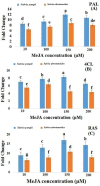The Influence of Methyl Jasmonate on Expression Patterns of Rosmarinic Acid Biosynthesis Genes, and Phenolic Compounds in Different Species of Salvia subg. Perovskia Kar L
- PMID: 37107629
- PMCID: PMC10137496
- DOI: 10.3390/genes14040871
The Influence of Methyl Jasmonate on Expression Patterns of Rosmarinic Acid Biosynthesis Genes, and Phenolic Compounds in Different Species of Salvia subg. Perovskia Kar L
Abstract
Salvia yangii B.T. Drew and Salvia abrotanoides Kar are two important fragrant and medicinal plants that belong to the subgenus Perovskia. These plants have therapeutic benefits due to their high rosmarinic acid (RA) content. However, the molecular mechanisms behind RA generation in two species of Salvia plants are still poorly understood. As a first report, the objectives of the present research were to determine the effects of methyl jasmonate (MeJA) on the rosmarinic acid (RA), total flavonoid and phenolic contents (TFC and TPC), and changes in the expression of key genes involved in their biosynthesis (phenylalanine ammonia lyase (PAL), 4-coumarate-CoA ligase (4CL), and rosmarinic acid synthase (RAS)). The results of High-performance liquid chromatography (HPLC) analysis indicated that MeJA significantly increased RA content in S. yungii and S. abrotanoides species (to 82 and 67 mg/g DW, respectively) by 1.66- and 1.54-fold compared with untreated plants. After 24 h, leaves of Salvia yangii and Salvia abrotanoides species treated with 150 M MeJA had the greatest TPC and TFC (80 and 42 mg TAE/g DW, and 28.11 and 15.14 mg QUE/g DW, respectively), which was in line with the patterns of gene expression investigated. Our findings showed that MeJA dosages considerably enhanced the RA, TPC, and TFC contents in both species compared with the control treatment. Since increased numbers of transcripts for PAL, 4CL, and RAS were also detected, the effects of MeJA are probably caused by the activation of genes involved in the phenylpropanoid pathway.
Keywords: Salvia; methyl jasmonate; total flavonoid content; total phenolic; transcriptome.
Conflict of interest statement
The authors declare no conflict of interest.
Figures





References
-
- Yilmaz A., Guler E., Soydemir H.E., Demirel S., Mollahaliloglu S., Karadeniz T., Ciftci V. Miracle. plant: Aronia (Aronia melanocarpa) MAS J. Appl. Sci. 2021;6:83–94.
-
- Yilmaz A., Karik Ü. AMF and PGPR enhance yield and secondary metabolite profile of basil (Ocimum basilicum L.) Ind. Crops Prod. 2022;176:114327. doi: 10.1016/j.indcrop.2021.114327. - DOI
-
- Mátis A., Malkócs T., Kuhn T., Laczkó L., Moysiyenko I., Szabó A., Bădărău A., Sramkó G. Hiding in plain sight: Integrative analyses uncover a cryptic Salvia species in Europe. Taxon. 2023;72:78–97. doi: 10.1002/tax.12818. - DOI
-
- Drew B.T., González-Gallegos J.G., Xiang C.L., Kriebel R., Drummond C.P., Walked J.B., Sytsma K.J. Salvia united: The greatest good for the greatest number. Taxon. 2017;66:133–145. doi: 10.12705/661.7. - DOI
Publication types
MeSH terms
Substances
LinkOut - more resources
Full Text Sources
Research Materials

